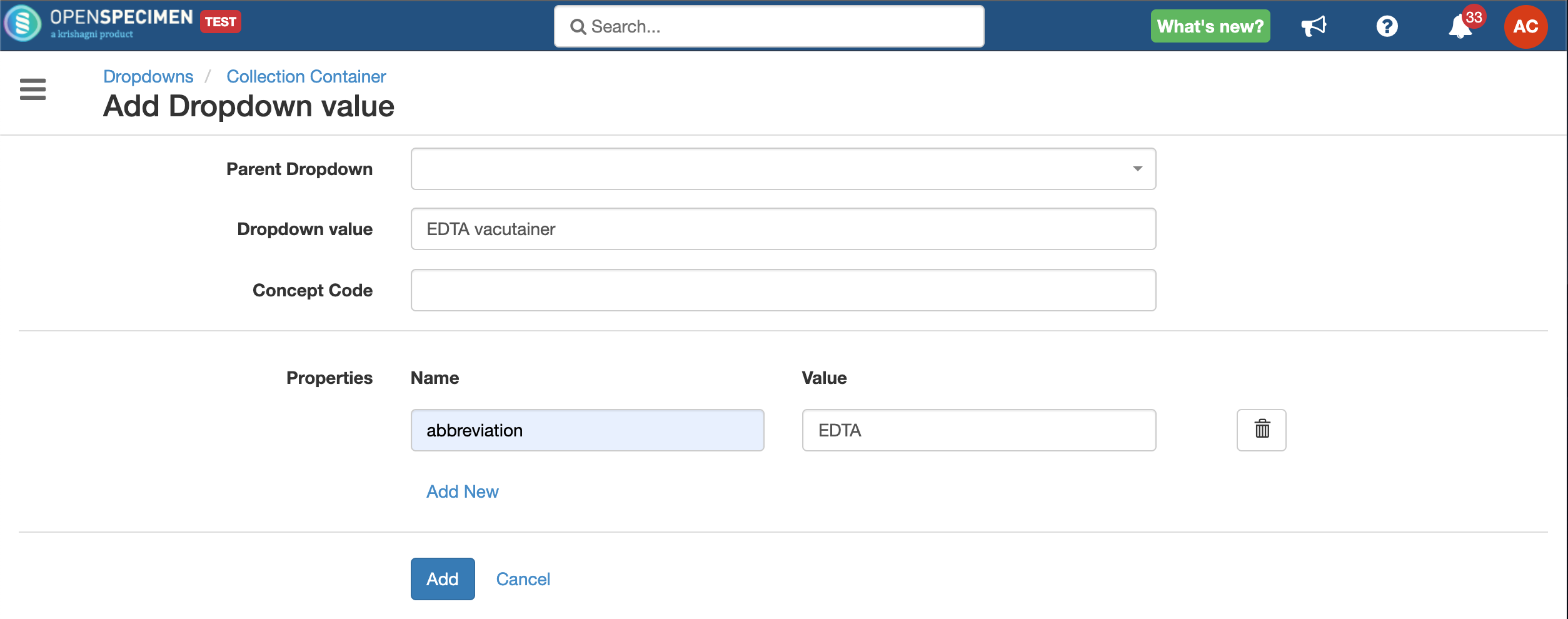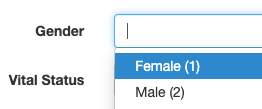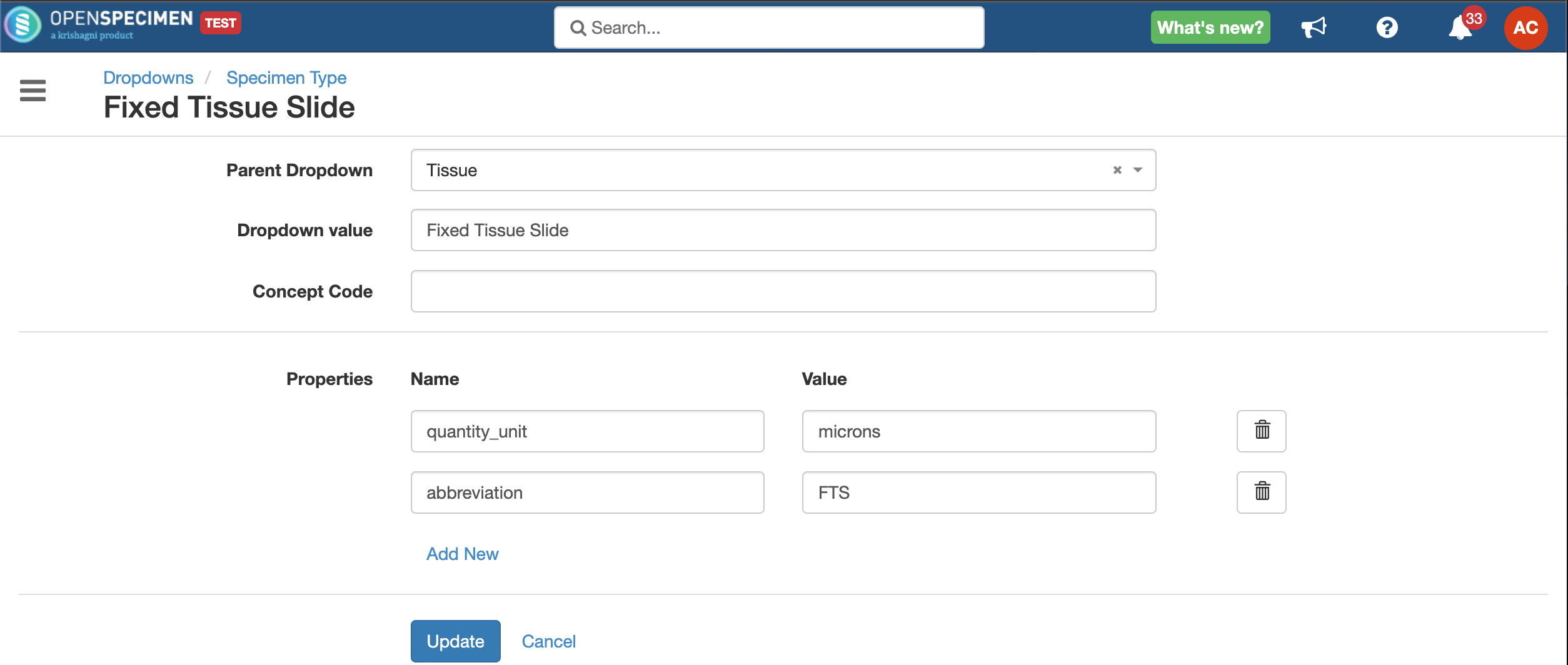| Table of Contents |
|---|
| Info | ||
|---|---|---|
| ||
This feature is available only in the Enterprise Edition |
Introduction
Using this plugin, super admins can update any dropdown list values in the application. To access, go to Home → Extras → Dropdown Manager.
Features include:
- Add a new dropdown
- Add new value
- Edit or delete existing values
- Import/Export values
- Set properties like units for specimen types, abbreviations, etc.
Add a new dropdown
...
Users can add a new dropdown altogether. Follow the below steps:
- Go to: Home → Extras → Dropdown Manager.
- Click on the "+Add" button.
- Enter the value of the 3 mandatory fields present on the screen
Unique ID: The unique attribute name of the dropdown. This is how the dropdown name will be saved in the database.
This appears in brackets once you click on an existing dropdown
Name: Name of the dropdown
Definition: Information regarding the dropdown
The name and definition appear on the dropdown list page as follows - Fill in all the three values and click on Add.
Add values
...
Go to: Home → Extras → Dropdown Manager.
Look for the field of interest. E.g., 'Collection Container'.
Click on the '+Add' to add new values.
...
If you want to assign a code to the value. E.g. SNOMED code, ICD code, or your own code (like 1 for Male, 2 for Female). If the concept code is set, it is displayed in the dropdown for that value. E.g.
This is useful especially in dropdowns like clinical diagnosis which has 1) a lot of values 2) standard vocabulary like SNOMED or ICD etc. During data entry, you can search by concept code rather than free text to avoid errors (since often you get SNOMED codes from the labs rather than text).
In the future, this will be available in the query interface to include the codes in the query results.
...
| Warning | ||
|---|---|---|
| ||
In order to add a new specimen type, it is mandatory to add it under one of these 4 parent dropdowns: Cell, Fluid, Molecular, or Tissue. If you include it under any other parent class, there are some functionalities that might break. |
Edit values
...
To edit, go to the overview page of the dropdown value and click 'Edit'.
Delete values
| Expand |
|---|
Deleting of values is supported only if the value is not used. A value cannot be deleted if it is used in previous records. To delete, go to the overview page of the dropdown value and click 'Delete'. To delete all the values in a dropdown, go to the required dropdown → click on "Delete All". |
Archive values
| Expand |
|---|
From v6.2, it is possible to archive the drop-down values which are no longer in use. To archive, a value, go to the overview page of the value and click 'Archive'. When a parent PV is archived, all its descendants are archived too. |
Re-activate the archived values
| Expand |
|---|
The archived values can be searched by selecting the activity status as 'Archived' in the search filter. |
Import CSV
...
To add multiple values, OpenSpecimen supports the upload of these values. To add multiple values
- Click on 'Extras' → 'Dropdown Manager'.
- Click Import → Dropdown values.
- Download the template CSV file.
- Enter the details as mentioned in the below table.
- Upload the file and click ' Validate and import'.
Fields description
...
Attribute
...
Should be 'Active' while adding a value
To delete: set to 'Disabled'.
To archive: set to 'Closed'
Properties
For some fields, there are extra properties that can be set. Below are the specimen-type properties
...
By default, the units are set at classes level which will apply to all types under it:
- Tissue: gm
- Fluid: ml
- Molecular: µg
- Cell: count
...
For example - µg/ml.
...
Table of Contents
| Info | ||
|---|---|---|
| ||
This feature is available only in the Enterprise Edition |
Introduction
Using this plugin, super admins can update any dropdown list values in the application. To access, go to Home → Extras → Dropdown Manager.
Features include:
- Add a new dropdown
- Add new value
- Edit or delete existing values
- Import/Export values
- Set properties like units for specimen types, abbreviations, etc.
Add a new dropdown
| Expand |
|---|
Users can add a new dropdown altogether. Follow the below steps:
|
Add values
| Expand | |||||||||||||||
|---|---|---|---|---|---|---|---|---|---|---|---|---|---|---|---|
|
Add properties to the values
| Expand | ||||||||||||||||||||||||
|---|---|---|---|---|---|---|---|---|---|---|---|---|---|---|---|---|---|---|---|---|---|---|---|---|
Below are the specimen-type properties
|
Edit values
| Expand |
|---|
Since v6.2, editing of dropdown values is supported via Dropdown manager - even if it is already used. All the records are automatically updated if the value is already used. To edit, go to the overview page of the dropdown value and click 'Edit'. |
Delete values
| Expand |
|---|
Deleting of values is supported only if the value is not used. A value cannot be deleted if it is used in previous records. To delete, go to the overview page of the dropdown value and click 'Delete'. To delete all the values in a dropdown, go to the required dropdown → click on "Delete All". |
Archive values
| Expand |
|---|
From v6.2, it is possible to archive the drop-down values which are no longer in use. To archive, a value, go to the overview page of the value and click 'Archive'. When a parent PV is archived, all its descendants are archived too. |
Re-activate the archived values
| Expand |
|---|
The archived values can be searched by selecting the activity status as 'Archived' in the search filter. |
Import CSV
| Expand | ||||||||||||||
|---|---|---|---|---|---|---|---|---|---|---|---|---|---|---|
To add multiple values, OpenSpecimen supports the upload of these values. To add multiple values
Fields description
PropertiesFor some fields, there are extra properties that can be set. Please refer to the 'Add properties to the values' section |
Export CSV (New in v6.1)
| Expand |
|---|
This is useful to move the dropdown values from test to production servers or use for reference during bulk imports. To export values for one or more fields, select the fields from the list and click on the 'Export' option: |
Update Dropdown Values
| Expand | ||
|---|---|---|
Update Concept Code (CSV)To bulk update the concept code of existing PVs:
Update Properties (CSV)To bulk update the properties of existing PVs:
Example file: Update_DropDown.CSV
|
Bulk Delete
| Expand |
|---|
To bulk delete the value on the basis of identifier set activity status as "Disabled" in the exported file.
Example file: Delete_Dropdown_Values.CSV |
Changing Specimen Type's Units
| Expand |
|---|
|
...
| Expand | |||||||||||||||
|---|---|---|---|---|---|---|---|---|---|---|---|---|---|---|---|
Below are the default values during installation.
|
...

















